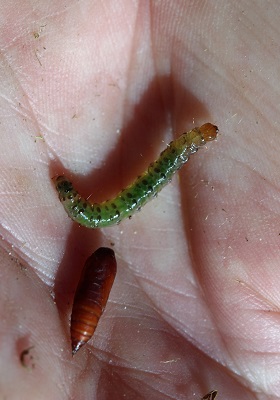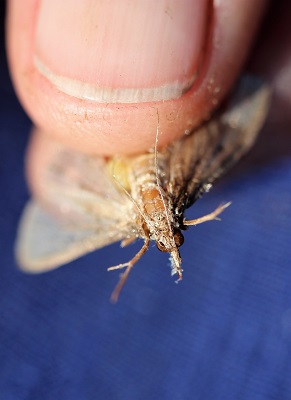Webworm population explosion may be imminent in Far North
16 Mar 2018
Warm, moist conditions mean the Far North is poised for a potentially serious explosion in the numbers of a voracious insect that can chew out entire paddocks of kikuyu virtually overnight.
Northland-based insect specialist Dr Jenny Dymock has been monitoring the tropical grass webworm (Herpetogramma licarsisalis) for the Northland Regional Council since the first serious outbreak of the pasture pest on the Aupouri Peninsula in 1999.
Dr Dymock says this year's warm, humid summer means tropical grass webworm (TGW) numbers on the Aupouri Peninsula have built up recently to a point where a formal alert for them is now being issued to local landowners.
 A tropical grass webworm caterpillar and pupa
A tropical grass webworm caterpillar and pupa
"The TGW populations are currently at various stages of their life cycle. Larvae will move into pupae and then large numbers of moths will emerge over the next few weeks and if the weather is still warm enough, these will lay a vast number of eggs."
She says as a rough rule of thumb, webworm caterpillars start to cause noticeable damage to kikuyu pasture when their numbers build up to about 50 per square metre and populations were already above this density in places.
Unless the weather cools significantly soon numbers of the insect pest could explode, at which stage TGW could become a serious problem for some farmers with sandy soils, who relied heavily on kikuyu pasture to feed their stock.
"When webworms build up to the point where you have hundreds of thousands per hectare, there are enough of them to literally chew out entire paddocks of kikuyu in just a day or two."
Dr Dymock says while strong, fast-acting organophosphate insecticides could be used for TGW, that was the least-desirable option for most farmers.
Scientific trials soon after the TGW's arrival in Northland – backed up by more recent trials near Awanui – had indicated that harrowing (which will break up the kikuyu mat) showed promise as a potential control by exposing TGW caterpillars to light and desiccation.
 An adult tropical grass webworm moth
An adult tropical grass webworm moth
She says adult webworm moths have been able reproduce in areas at the tip of the Far North (north of Awanui) since the late 1990s, but at this stage have not persisted in cooler areas, even the southern parts of Northland.
"Even in the Far North, population growth of TGW slows down with the onset of colder weather, with a few surviving in frost-free sheltered sites over winter. These can reinfest the region in the next summer if the weather conditions are suitably tropical."
At the moment, TGW could be found at Paparore, Waiharara, Motutangi, around Pukenui and further north at Ngataki.
Dr Dymock says she is keeping a close eye on TGW, monitoring their numbers at a number of Far North sites on a weekly basis and keeping in close contact with affected landowners.
She says given the upsurge in TGW numbers, monitoring results will be posted on the regional council's website via www.nrc.govt.nz/pestcontrolhub until the onset of cooler weather.
